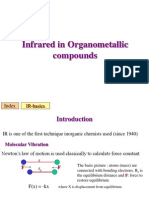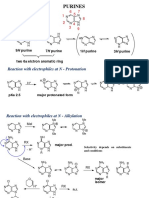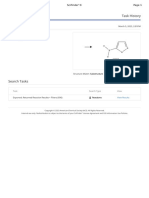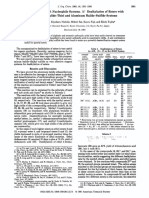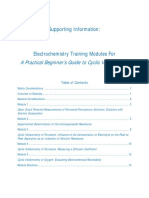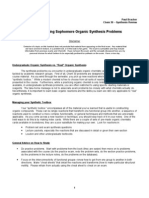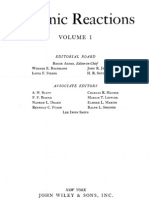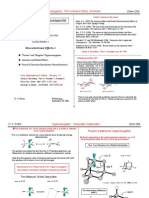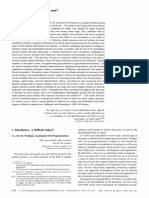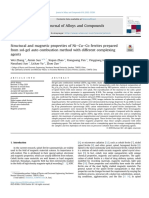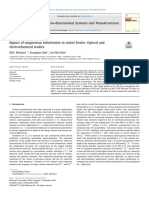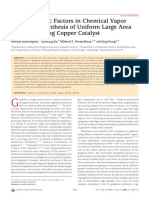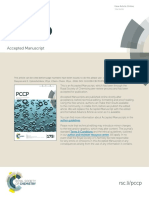100%(1)100% found this document useful (1 vote)
1K views827 pagesClassics in Total Synthesis.
Uploaded by
Juancho PachonCopyright
© © All Rights Reserved
We take content rights seriously. If you suspect this is your content, claim it here.
Available Formats
Download as PDF or read online on Scribd
100%(1)100% found this document useful (1 vote)
1K views827 pagesClassics in Total Synthesis.
Uploaded by
Juancho PachonCopyright
© © All Rights Reserved
We take content rights seriously. If you suspect this is your content, claim it here.
Available Formats
Download as PDF or read online on Scribd
You are on page 1/ 827
K.C.NICOLAOU, E. J. SORENSEN
CLASSICS IN
TOTAL
SYNTHESIS
Classics in Total Synthesis K.C. Nicolaou and
E.J. Sorensen
Other successful books in organic chemistry from VCH
IM. Lehn
Supramolecular Che
Concepts and Perspectives
1995, X, 271 pages with 51 figures.
Hardcover. ISBN 3-527-29312-4.
Softcover. ISBN 3-527-29311-6.
J. Fuhthop, G. Penzl
Organic Synthesis - Concepts, Methods, Starting Materials
Second, Revised and Enlarged Edition
With a Foreword by E.J. Corey
1994. XVI, 432 pages with 16 figures and 37 tables.
Hardcover. ISBN 3-527-29086-9
Softcover. ISBN 3-527-29074-5.
M. Nogradi
Stereoselective Synthesis — A Practical Approach
Second, Thoroughly Revised and Updated Edition
With a Foreword by A.I. Meyers
1994. XVI, 452 pages with 171 figures and 23 tables.
Hardcover. ISBN 3-527-29242-X.
Softcover. ISBN 3-527-29243-8,
D.P. Curran, N.A. Porter, B. Giese
Stereochemistry of Radical Reactions — Concepts, Gt
and Synthetic Applications
1995, XII, 280 pages with 31 figures and 2 tables.
Hardcover. ISBN 3-527-29372-8.
H. Waldmann (Ed.)
Organic Synthesis Highlights II
1995. XIII, 407 pages with 318 figures and 3 tables.
Hardcover. ISBN 3-527-29200-4,
© VCH Verlagsgesellschalt mbH, D-60451 Weinheim (Federal Republic of Germany), 1996
oat 1
Distribution:
VCH, P.O. Box 101161, D-6945) Weinheim, Federal Republic of Germany
Switzerland: VCH, P.O. Box, CH-8020 Basel, Switzerland |
United Kingdom and Kreland: VCH, 8 Wellington Court, Cambridge CBI 1HZ,
United Kingdom
USA and Canada: VCH, 220 Bast 25rd Street, New York, NY 10010-4606, USA.
Japan: VCH, Eikow Building, 10-9 Hongo l-chome, Bunkyo-ku, Tokyo 113, Japan
ISBN 3-527-29284-5 ISBN 3-527-20231-4
Classics in Tota
Synthesis
Targets, Strategies, Methods
With a Foreword by
E.J. Corey
(iL
VCH"!
K.C. Nicolaou and
E.J. Sorensen
Weinheim
New York
Basel
Cambridge
Tokyo
K.C, Nicolaou, Ph. D.
Erik J, Sorensen, Ph. D.
Department of Chemistry ‘and Department of Chemistry and Biochemistry
The Scripps Research Institute University of California, San Diego
10666 North Torrey Pines Road 9500 Gilman Drive
La Jolla, CA 92037 La Jolla, CA. 92093,
USA USA
‘This book was carefully produced. Nevertheless, authors and publisher do not warrant the information contained therein to be free
if errors. Readers are advised to Keep in mind that statements, data, illustrations, procedural details or other items may inadver
tently be inaccurate
Published jointly by
VCH Verlagsgeselischaft mbH, Weinheim (Federal Republic of Germany)
‘CH Publishers, In., New York, NY (USA)
Copy Editor: Dr. Rachel Schmidt-Radde
Production Manager: Dipl.-Ing. (FH) Hans Jorg Maier
Front cover: A red-tide incident that occurred on 8th May 1976, off Matsushima Istand, in Hyogo Prefecture, Japan, The structure
‘shown is that of brevetoxin B, a neurotoxin produced by algae that proliferate during red-tide incidents. Brevetoxin B
is believed to have been responsible for massive fish killings and poisoning of humans who ate affected seafood. The
total synthesis of brevetoxia Bis described in Chapter 37 of this book,
Back cover: Structure of vitamin By.
Library of Congress Card No. applied for
‘A catalogue record for this book is available from the British Library.
Deutsche Bibliothek Cataloguing-in-Publication Data:
Nicolaou, K.C.
Classics in total synthesis / K.C. Nicolaou and Erik J.
Sorensen, - Weinheim ; New York ; Basel ; Cambridge ; Tokyo
VCH, 1996
ISBN 3-527-29284-5 Pp.
ISBN 3-527-29231-4 brosch.
NB: Sorensen, Erik J:
© VCH Veriagsgeselschaft mbH, D-69451 Weinheim (Federal Republic of Germany), 1996
Printed on acid-free and chlorine-ree paper
All rights reserved (including those of translation in other languages). No part of this book may be reproduced in any form ~ by photo.
printing, microfilm, or any other means - nor transmitted or translated into machine language without writen permission from the
Publishers. Registered names, trademarks, etc. used in this book, even when not specifically marked as such, are not to be considered
“unprotected by law.
Composition: Fa, Hagedornsatz GmbH, D.68519 Viemheim,
Printing: Zechnersche Buchdruckerci, D-67346 Speyer.
Bookbinding: Wilhelm Osswald & Co, D-67433 Neustadt.
Printed in the Federal Republic of Germany.
Foreword
Ifa definitive history of twentieth century science is ever written, one
of the highlights may well be a chapter on the chemical synthesis of
complex molecules, especially the total synthesis of naturally occur-
ring substances. I state this, while trying to be as objective as possible,
because it is not easy to find an area of scientific work that encom-
asses so many interesting elements. I shall name just a few: great com-
plexity and variety; challenge verging on impossibility; demand for
both mental and manipulative rigor, and for dedication, persistence,
and hard work; never-ending frontiers for discovery and never-ending
advances in sophistication; unlimited opportunities for intellectual
excitement and satisfaction; strong coupling not only with all areas of
chemistry, but also with biology and medicine: relevance, at a very fun-
damental level to human well-being, health, and education
As I read a prepublication draft of “Classics in Total Synthesis”,
all of these general characteristics of synthetic research assumed a
reality and sharpness that I had not expected, partly because 1 was
already familiar with each of the thirty-seven classics in this collec-
tion. It was a sheer delight to revisit each of these triumphs guided
by the wise insights and analyses found throughout this book.
There is a nice balance between the underlying historical material
and the design and execution aspects of each synthesis. In addition,
the broad perspectives on synthesis, supplemented in each section
by detailed explanations of the key features of each synthesis, lead
toa presentation that is both clear and stimulating. The pedagogy is
effective
As mentioned by the authors in their preface, the achievements in
total synthesis have been so numerous and so important that it is
Clearly impossible to include them all in a single volume. My hope is
that “Classics in Total Synthesis” will be successful and that it will
be followed by a continuing series. Such a colléction will add to our
reading pleasure and further encourage and inspire new generations
of chemists to dare the impossible (or even the unfashionable). There
is much still to be leamed and to be discovered. Humanity will be
enriched beyond measure if the twenty-first century is a period of
continued vigorous development of synthetic chemistry.
I would like to congratulate Professor Nicolaou and Dr, Sorensen
on this fine addition to the literature of synthetic chemistry and to
wish them well in their further work as scientists and as authors. May
the joumey in total synthesis follow the Ithaca model (page 16)
E.J. Corey
Harvard University
30 October 1995
Abbreviations
Ac acetyl
cae acetylacetonyl
AD asymmetric dihydroxylation
AIBN 2,2-azobisisobutyronitrile
BBEDA N,N'-bis(benzylidene)ethylenediamine
9-BBN 9-borabicyclo[3.3.1}nonane
BINAL-H 2,2-dihydroxy-1,1’-binaphthylaluminum.
BINAP
Bn benzyl
BOC (-BOC)’ tert-butoxycarbonyl
BOM benzyloxymethyl
BTMSA bis(trimethylsilylacetylene
Bz benzoyl
18-C-6 18-crown-6
Cbz benzyloxycarbonyl
CHD coronary heart disease
CoA
cop
Cp
CSA
Cy (Cy-Hex)
DAIB
DAST
dba
DBN
DBs
DBU
DCBI
pec
D_Q
de
DEAD
DEIPS
DET
DHP
DHQ
DHQD
DIAD
Dibal-H
DIOP
DiPAMP
DIPT
DMA
4-DMAP.
(DMAP)
DME
DMF
DMs
DMSO
DNA
1-DOPA,
DPC
DTBMS.
EDC (EDCH
e
ee
EE
Et-DuPHOS
Fmoe
FPP
coenzyme A
1,5-cyclooctadiene
cyclopentadieny!
10-camphorsulfonic acid
ceyclohexy?
3-ex0-(dimethylamino)isoborneo!
diethylaminosulfur trifluoride
trans, trans-dibenzy
1,5-diazabicyclo[4.3.0)non-5-ene
S-dibenzosuberyl
1,8-diazabicyclo[5.4.0]undec-7-ene
NN'-dicyclohexyl-O-benzylisourea
1,3-dicyclohexylcarbodiimide
2/3-dichloro-5,6-dicyano-1,4-benzoquinone
diastereomeric excess
diethyl azodicarboxylate
diethylisopropylsily!
diethy! tartrate
3.4-dihydro-2H-pyran
dihydroquinine
dibydroquinidine
diisopropyl azodicarboxylate
diisobutylaluminum hydride
2,3-O-isopropylidene-2,3-dihydroxy-1,4-
bis(diphenylphosphino)butane
1,2-bis(o-anisylphenylphosphino)ethane
diisopropy! tartrate
N,N-dimethylacetamide
4-dimethylaminopyridine
ethylene glycol dimethyl ether
N.N-dimethylformamide
dimethy! sulfide
dimethyl sulfoxide
deoxyribonucleic acid
3-(3,4-dihydroxyphenyl:
dipyridine chromium(vi) oxide
di(fert-buty!)methylsily!
1-(3-dimethylaminopropyl)-3-ethylearbodii-
hydrochloride
electron
enantiomeric excess
1-ethoxyethy!
1,2-bis(2',5'-diethylphospholanoyethane
9-fluorenylmethoxycarbonyl
farnesyl pyrophosphate
Gc
HETE
hfe
HMPA
HMG
HPLC
HWE
Im (imid.)
IND
Ipe
KHMDS
LDA
LHMDS
mCPBA
MEM
MOM
Ms
NaHMDS
NB
pNB
NBS
NCS
NIS
NMM
NMO
NMP
PNNP
PPTS
psi
pyr. (pyr, Py)
PYR
Ra-Ni
Red-Al
SAE
SEM
Sia
TBAF
TBAL
TBS
TEOC
gas chromatography
hydroxyeicosatetraenoic
3-{hepiafluoropropylhydroxymiethylene |v
camphorato
hexamethylphosphoramide
hydroxymethylelutaryl
high-pressure liquid chromatography
Homer-Wadsworth-Emmons
imidazole
indoline
isopinocamphey!
potassium bis(trimethylsilylamide
lithium diisopropylamide
lithium bis(trimethylsilylamide
3-chloroperoxybenzoic acid
2-methoxyethoxymethyl
methoxymethyl
methanesulfanyl
sodium bis(trimethylsily!)amide
2-nitrobenzy!
4-nitrobenzyl
N-bromosuccinimide
N-chlorosuccinimide
N-iodosuccinimide
4-methylmorpholine
4-methylmorphotine N-oxide
I-methyl-2-pyrrolidinone
nnclear magnetic resonance
nucleophile
pyridinium chlorochromate
pyridinium dichromate
prostaglandin
pheny!
phthalazine
phthalimido
pivaloy!
4-methoxybenzy!
N,N’-bis(1-phenylethy)-N,N’-bis-(diphe-
nylphosphino)ethylenediamine
pyridinium 4-toluenesulfonate
‘pounds per square inch
pyridine
diphenyipyrimidine
Raney nickel
sodium bis(2-methoxyethoxy)aluminum
hydride
Sharpless Asymmetric Epoxidation
2-(trimethylsilyethoxymethy!
siamyl
tetra-n-butylammonium fluoride
tetra-n-butylammonium iodide
tert-butyldimethylsily!
2-(trimethylsilyethoxycarbonyl
triethylsily!
trifluoromethanesulfonyl
trifluoroacetic acid
trifluoroacetic anhydride
tetrahydrofuran
tetrahydropyranyl *
triisopropylsilyl
N.N.N’,N'-tetramethylethylenediamine
trimethylsilyl
tetra-n-propylammoniuim perruthenate
tert-butyldiphenylsilyl
triphenylmethy!
4-toluenesulfonyl
Preface
This book is intended to be an historical record of some of the
greatest total syntheses of all time. We also hope that it will serve
as a teaching and learning tool for teachers, students, and practi-
tioners of organic synthesis. In Chapter 1, the reader will find a dis-
cussion on the philosophy, purpose, and use of total synthesi
each of the remaining 36 chapters, we describe the total synthesis
of a natural product. Through the examples chosen, an effort was
made to trace the evolution of the science of total synthesis to its
present state and to demonstrate the utility of important chemical
reactions in the construction of target organic molecules. Despite
the diversity of structures, each total synthesis is presented in a uni-
fying pedagogical format, which hopefully distinguishes this book
from any other.
In the Introduction section of each chapter, the background and
biological action of the target molecule is discussed, and the impor-
tant synthetic reactions involved in the synthesis are presented.
Following the introduction is the Retrosynthetic Analysis and
Strategy section, in which the target molecule is analyzed retro-
synthetically to show and explain the evolution of the synthetic
strategy. In the Total Synthesis section, the execution of the syn-
thesis is discussed, with special emphasis placed on tactics, effi-
ciency, selectivity, stereochemistry, and synthetic maneuvering. The
Conclusion section summarizes in a concise manner the main find-
ings and impact of the total synthesis
Throughout each chapter, clear structures, schemes, and figures
accompany the text. Mechanism, reactivity, selectivity, and stereo-
chemistry are especially addressed. Special emphasis is also placed
on introducing both the logic of total synthesis and the rationale for
the invention and use of important synthetic methods. In particular,
we amplify the most important developments in asymmetric synthe-
sis, catalysis, cyclization reactions, and organometallic chemistry.
This volume is based partly on the lecture notes of K.C.N. that
were used for teaching courses at the University of Pennsylvania,
the University of California, San Diego, and The Scripps Research
Institute. We apologize sincerely to those whose brilliant works
have been left out owing to the inevitable closing of the curtain and
hope that in the event of a second volume we can rectify these
omissions. We also apologize in advance for the inevitable errors
that a volume of this size may contain, and welcome constructive
comments from our readers in order to correct such errors in future
editions,
It is our hope that this book will find its way into the hands of
every student of organic synthesis and that it will serve both to edu-
vill
Preface
cate and inspire. If we can excite and stimulate a new generation of
chemists in the direction of organic synthesis, then we will be satis
fied that a major part of our goal has been reached.
We wish to thank Janise L. Petrey for her tenacity, skill, and
patience in processing the many and fragmentary versions of this,
book. We would also like to thank Alan Nadin for his thoughtful
comments and useful suggestions on various aspects of the manu-
script. We are grateful to Chris F. Claiborne, Otto Griither, R. Kip
Guy, John |. Trujillo, and Eddy W. Yue for their assistance and for
checking the references. We thank Professors Charlie L. Perrin, Jay
S. Siegel, and Emmanuel A. Theodorakis for useful discussions and
suggestions, and Vicky Nielsen for her managerial skills in keeping
us all together, We owe our many thanks to Georgette, Colette,
Alex, Chris, and P.J. Nicolaou and Karla Sorensen for their support
and patience during this odyssey, and we offer our apologies for
not being there when we should have been ..
Our sincere appreciation goes to all the members of the
K.C.N. group whose dedication, brilliance, and diverse ethnic
background have made this group's contributions both possible and
enjoyable,
Finally, we would like to dedicate this book to Professor
E.J. Corey, whose teachings and research have helped shape the
science of organic synthesis and the art of total synthesis as we
know it today.
La Jolla K.C. Nicolaou
October 1995 E.J. Sorensen
About the Authors
K.C. Nicolaou was born in
1946 in Cyprus. He studied
chemistry at the University of
London (B.Sc., 1969; Ph.D.,
1972), Columbia University
(postdoctoral research) and
Harvard University (postdoc-
toral research), Between 1976
and 1989 he was a faculty
member at the University of
Pennsylvania. He currently
holds joint appointments at The
Scripps Research Institute,
where he is the Darlene Shiley
Professor of Chemistry and
Chairman of the Department of '
Chemistry, and at the Univer-
sity of California, San Diego,
where he is Professor of Chem-
istry. His research interests
span the areas of synthetic
organic chemistry, bioorganic
chemistry, molecular design,
and the chemistry and biology
of natural products.
x About the Authors
Erik J. Sorensen was born in
1966 in Oneida, New York. He
graduated from Syracuse Uni-
versity with a B.A. in chemis-
try. He received his Ph.D.
degree in chemistry from the
University of California, San
Diego in 1995 working under
the guidance of Professor K.C.
Nicolaou. His research interests
are in the areas of total syn-
thesis and reaction engineering
Contents Overview
. Introduction: Constructing the
Molecules of Nature
2. Strychnine (R. B. Woodward) (1954)
3. Penicillin V (J.C. Sheehan) (1957)
4, Reserpine (R. B. Woodward) (1958)
5, Prostaglandin Faq (PGF2q) and (E.J. Corey) (1969)
Prostaglandin E> (PGE2)
6. Progesterone (W.S. Johnson) (1971)
7. Carpanone (O.L. Chapman) (971)
8. Vitamin B12 (R.B. Woodward and (1973)
A. Eschenmoser)
9. Prostaglandin A> (PGA2) and (G. Stork) (1976, 1978)
Prostaglandin Faq (PGF2a)
10, Estrone (K. P.C. Vollhardt) (1977)
11. Erythronolide B (E. J. Corey) (1978)
12. Monensin (¥. Kishi) (1979)
13. Periplanone B (W.C. Still) (1979)
14, Isocomene (M.C. Pirrung) (1979)
15. Monensin (W.C. Still) (1980)
16, Thienamycin (Merck) (1980)
17. Endiandric Acids (K.C. Nicolaou) (1982)
18. Biotin (Hoffmann-La Roche) (1982)
19. -Hexoses (S. Masamune and (1983)
K.B. Sharpless)
20. Asteltoxin’ (S.L. Schreiber) (1983)
21. Periplanone B (S.L. Schreiber) (1984)
22. Menthol (Takasago) (1984)
23. Hirsutene and A%'2)-Capnellene (D. P. Curran) (1986)
24, Amphoteronolide B and (K.C. Nicolaou) (1987)
Amphotericin B
25. Ginkgolide B (E.J. Corey) (1988)
26. Methyl Homosecodaphniphyllate —_ (C. H. Heathcock) (1988)
27. Indolizomycin (S.J. Danishefsky) (1990)
28. Cytovaricin (D.A. Evans) (1990)
29, Gilvocarcin M and Gilvocarcin V—_(K. Suzuki) (1992, 1994)
30. Calicheamicin y} (K.C. Nicolaou) (1992)
31, Rapamycin (K.C. Nicolaou) (1993)
32. Paconiflorigenin and Paeoniflorin (E.J. Corey) * (1993)
33. Strychnine (L.E. Overman) (1993)
34. Taxol (K.C. Nicolaou) (1994)
35, Zaragozic Acid A/Squalestatin $1 (K. C. Nicolaou) (1994)
36. Palytoxin (¥. Kishi) (1994)
37. Brevetoxin B (K.C. Nicolaou) (1995)
Table of Contents
Chapter 1
Introduction: Constructing the
Molecules of Nature
1.1 Synthetic Chemistry and Total Synthesis .. . .
1.2 The Scope of Organic Synthetis..
1.3. A Brief History of Organic Synthesis
1.4 The Practice of Total Synthesis
1.5. Target Molecules . : :
1.6 Natural Products as Synthetic Targets .
1.7 Designed Molecules as Synthetic Targets,
1.8 Synthetic Strategy gosneoeo
1.9 Retrosynthetic Analysis
1.10 Classics in Total Synthesis . ..
Chapter 2
Strychnine
R.B. Woodward (1954)
2.1. Introduction
22. Retrosynthetic Analysis and Strategy
2.3 Total Synthesis bees
24 Conclusion .......
Chapter 3
Penicillin V
J.C. Sheehan (1957)
3.1. Introduction .
3.2 Retrosynthetic Analysis and Strategy...
3.3 Total Synthesis . .
3.4 Conclusion ...
21
22
21
40
4
44
45
50
XIV
Table of Contents
Chapter 4
Reserpine
R.B. Woodward (1958)
4.1. Introduction
4.2 *Retrosynthetic Analysis ‘and Suey :
4.3. Total Synthesis.
44 Conclusion ....
Chapter 5
Prostaglandin F2q (PGF2q)
and Prostaglandin Ez (PGE2)
E.J. Corey (1969)
Sl Introduction .
5.2 Retrosynthetic ‘Analysis ‘and I Sateey
5.3 Total Synthesis...
5.4 Conclusion
Chapter 6
Progesterone
W.S. Johnson (1971)
6.1 Introduction .....
6.2 Retrosynthetic Anas ‘and Seategy
6.3 Total Synthesis
64 — Conclusion
Chapter 7
Carpanone
O.L. Chapman (1971)
7.1 Introduction .
72 Rewrosynthetic Analysis and. a Sitegy
7.3. Total Synthesis.
7.4 — Conclusion
65
67
a
81
83
85
88
92
Table of Contents
Chapier 8
Vitamin Bj2
R.B. Woodward and A. Eschenmoser (1973)
8.1
8.2
83
8.3.1
8.3.2
8.3.3
8.3.4
8.3.5
8.3.6
8.3.7
8.3.8
8.3.9
84
Introduction .
Retrosynthetic Analysis and Strategy
Total Synthesis...
The Woodward Synthesis of Cyanobromide 6 .
The Eschenmoser Synthesis of B-Ring Intermediate 8
. WS
The Woodward Synthesis of C-Ring Intermediate 9 .
The Eschenmoser Synthesis of C-Ring Intermediate 9 .
- a7
‘The Eschenmoser Synthesis of Thiodextrolin (7) .
‘The Woodward-Eschenmoser Mactocyclization
Strategy .....
The Eschenmoser Synthesis of A-Ring Intermediate 24
and D-Ring Intermediate 25 ........ :
The Eschenmoser Cyclization Strategy ne
Completion of the Woodward-Eschenmoser Total
Synthesis, of Coby. ‘Acid and Vitamin Biz .
Conclusion paaeenee
Chapter 9
Prostaglandin Az (PGA2)
and Prostaglandin F2q (PGF 2a)
G. Stork (1976, 1978)
9.1 Introduction oe
9.2 Retrosynthetic Analysis and Strategy for PGA2
9.3 Total Synthesis of PGA2... . oe
944 Retrosymthetc Analysis and Strategy f ‘for PGFs. i"
9.5 Total Synthesis of PGF2a - .
9.6 Conclusion ......... :
Chapter 10
Estrone
K.P.C. Vollhardt (1977)
10.1 Introduction . pee eee e eee
10.2 Retrosynthetic Amys a ‘and Sustepy
10.3 Total Synthesis .
10.4
Conclusion .
99
‘100
105
- 105
113,
us
121
123
126
130
. 134
. 137
138
140
144
146
151
. 153
160
© 162
- 165
Table of Contents
Chapter 11
Erythronolide B
E.J. Corey (1978)
I Introduction . a
11.2... Retrosynthetic Analysis and Suategy 5
11.3 Total Synthesis . . .
il Conclusion .
Chapter 12
Monensin
¥. Kishi (1979)
12.1
12.2
123
12.4
Introduction ,
Retrosynthetic Analysis: and Siategy
Total Synthesis .
Conclusion. .
Chapter 13
Periplanone B
WC. Still (1979)
13.1
13.2
13.3
13.4
Introduction .
Retrosynthetic Analysis and Site
Total Synthesis
Conclusion .
Chapter 14
Isocomene
M.C. Pirrung (1979)
14.1
14.2
143
14.4
Introduction .. . .
Retrosynthetic Analysis and Surteey
Total Synthesis
Conclusion
167
- 169
172
183
~ 185
- 187
- 194
- 207
- 21
212
215
219
221
- 221
223
1. 225
Table of Contents
Chapter 15
Monensin
W.G, Still (1980)
15.1 Introduction . 2207
15.2 Retrosynthetic Analysis and Siteay : 230
15.3. Total Synthesis. ......... » 238
15.4 Conclusion 246
Chapter 16
Thienamycin
Merck (1980)
16.1 Introduction . . .. . 249
16.2 Retrosyntete Analysis and Strategy : 250
251
. 262
16.3 Total Synthesis
16.4 Conclusion .
Chapter 17
Endiandric Acids A-D
K.C. Nicolaou (1982)
265
267
17.1 Introduction... 06. eee
17.2 Retrosynthetic Analysis and Strategy
17.3. Total Synthesis ....... 270
17.3.1 Stepwise, Stereocontrolled Total Synthesis of
Endiandric Acids A-D (and E-G).......-....- +. 270
17.3.2. “Biomimetic”, One-Step Total Synthesis of
Endiandric Acids A- D (and E-G) pee eel
17.4 Conclusion eee 283
Chapter 18
Biotin
Hoffmann-La Roche (1982)
18.1 Introduction . 5 veces 285
182 Retrosynthetic Analysis and Swateny ce eee esses ees 286
isaieeroml symbole ere eee)
18.4 Conclusion : 291
xvi
XVII Table of Contents
Chapter 19
L-Hexoses
S. Masamune and K.B. Sharpless (1983)
19.1 Introduction a wee eens 293
19.2 Retrosynthetic Analysis a ‘and | Seatey - cess. 298
19,3 Total Synthesis . wee 310
19.4 Conclusion .........
Chapter 20
Asteltoxin
S.L. Schreiber (1983)
20.1 Introduction
20.2 Retrosynthetic Analys
20.3 Total Synthesis
204 Conclusion ..... 02... sees
and Strategy... .
Chapter 21
Periplanone B
S.L. Schreiber (1984)
21.1 Introduction . . bese 333,
21.2 Retrosynthetic Analysis and Seay : 336
21.3 Total Synthesis ..... 2. 337
214 Conclusion 2... eeec cece. 340
Chapter 22
Menthol
Takasago (1984)
22.1 Introduction... bee eeee eens 343
22.2 Retrosynthetic Analysis and: Suatey peer 354)
22.3. Total Synthesis... oe 355
22.4 Conclusion ...... 0... 357
22.5 Appendix: Catalytic Asymmetie Restos,
an Overview ..... fee eeete access 388
Table of Contents
Chapter 23
Hirsutene and
A%!2)_Capnellene
D.P. Curran (1986)
23,1 Introduction 381
232 Retrosynthetic Analysis and Strategy. 409
23.3. Total Synthesis. 410
23.4 Conclusion. . 416
Chapter 24
Amphoteronolide B and
Amphotericin B
K.C. Nicolaou (1987)
24.1. Introduction . 421
24.1.1 Degradation Studies 421
24.2 Retrosynthetic Analysis and Strategy 425
24.3. Total Synthesis. 429
24.3.1 Construction of Building Blocks 16 and 19 429
24.3.2 Construction of Building Blocks 17 and 18:
‘The Carbohydrate Approach .... . 432
24.3.3 Construction of Building Blocks 17 and 18:
The Sharpless Asymmetric Epoxidation Approach... 434
24.3.4 Completion of the Synthesis of
Amphoteronolide B 438
24.3.5 Completion of the Synthesis of |
Amphotericin B 444
24.4 Conclusion . 448
Chapter 25
Ginkgolide B
E.J. Corey (1988)
25.1 Introduction... see eee cee cece eee . 451
25.2 Retrosynthetic Analysis and Strategy 452
25.3 Total Synthesi 456
25.4 Conclusion . 463
XIX
Tabie of Contents
Chapter 26
Methyl
Homosecodaphniphyllate
C.H. Heathcock (1988)
26.1 Introduction
26.2 Retrosynthetic Analysis and sineay
26.3 Total Synthesis
264 Conclusion
Chapter 27
Indolizomycin
S.J. Danishefsky (1990)
27.1 Introduction... .
27.2 Retrosynthetic Analysis a and Seateey
27.3 Total Synthesis...
27.4 Conclusion
Chapter 28
Cytovaricin
D.A. Evans (1990)
28.1 Introduction ee
28.2. Retrosynthetic Analysis and Strategy
28.3 Total Synthesis...
28.3.1 Synthesis of Spiroketal Subunit 6.
28.3.2. Synthesis of Polyol Glycoside Subunit
28.3.3 Synthesis of Seco Acid 4 and Completion of the.
Total Synthesis of Cytovaicin L
28.4 Conclusion . senna
- 465
465
1. 467
469
.. 471
472
483
- 485
487
. 491
491
497,
- 503
506
Table of Contents
Chapter 29
Gilvocarcin M and
Gilvocarcin V
K. Suzuki (1992, 1994)
29.1 Introduction... .. . 509
29.2 Retrosynthetic Aodyss and Sateey 510
29.3 Total Synthesis 512
29.4 Conclusion 519
Chapter 30
; eee
Calicheamicin y}
K.C. Nicolaou (1992)
30.1, Introduction ..... beceveeee eee 523
30.2 Retrosynthetic Analysis and Sutey « wees 525
30.3 Total Synthesis ..... ». 535
30.3.1 Synthesis of Oligosaccharide 8 « - 535)
30.3.2 Synthesis of Aglycon 5 ..... 548
30.3.3. Coupling of Intermediates 8 and 9 and Completion of
the Total Synthesis of Calicheamicin a a . 556
30.4 Conclusion ....... bec cee sees 562
Chapter 31
Rapamycin
K.C. Nicolaou (1993)
Sis] guinioductione re eee cree te 565
31.1.4 The Heck Reaction. bevee ees , 566
31.1.2 Palladium-Catalyzed Cycloisomerizations . . . ». 528
31.1.3 The Stephens-Castro and the Sonogashira Coupings - 582
31.1.4 The Suzuki Coupling » 586
31.1.5 The Stille Coupling
31.2 Retrosynthetic Analysis and Strategy
31.3. Total Synthesis ...............
.. 591
. 599
607
31.3.1. Synthesis of Intermediates 147 and 158-160 » 607
31.3.2 Coupling of Key Intermediates 147 and 158-160... . 620
31.3.3 Final Stages and Cyclization to Rapamycin ........ ..624
31.4 Conclusion ....... 6.6.2 e cece eee «++ 626
Table of Contents
Chapter 32
Paeoniflorigenin and
Paeoniflorin
E.J. Corey (1993)
B21 Introduction .... 00... ceeeeseeeveesee eee 633
32.3 Retrosynthetic Analysis and Strategy... te. 633
32.3. Total Synthesis ........ 636
32.4 Conclusion .. 640
Chapter 33
Strychnine
LE. Overman (1993)
33.1 Introduction -... O41
33.2 Retrosynthetic Analysis and Strategy ..... «. 643
33.3. Total Synthesis. ven : - 646
33.4 Conclusion 652
Chapter 34
Taxol
K.C. Nicolaou (1994)
34.1 Introduction... . bee +. 635
34.2 Retrosynthetic Analysis and Strategy... 2.2... 656
34.3. Total Synthesis ceeeees . vee 660
34.4 Conelusion 2.02... veeveeeee OTL
Chapter 35
Zaragozic Acid A/
Squalestatin S1
K.C. Nicolaou (1994)
35.1 Introduction . 673
35.1.1 The Asymmetric Dihydroxylation .. . 675
35.2 Retrosynthetic Analysis and Strategy . 691
35.3. Total Synthesis... bees. 694
35.3.1 Degradation and Reconstitution Chemistry + 694
35.3.2 Synthesis of Key Intermediate Aldehyde 68 695
35.3.3 Model Studies ....... cette eee eee eee es 699
Table of Contents
35.3.4. Synthesis of the Side Chains : - 702
35.35 Coupling of Key Intermediates and Completion ofthe
Total Synthesis of Zaragozic Acid id A/Squaesain SI. 704
35.4 Conclusion ....... 0... 0eeereee ener ees » 707
Chapter 36
Palytoxin
¥, Kishi (1994)
36.1 Introduction . . . 7
36.1.1 The NiCl/CrCl Coupling Reaction viernes 2
36.2 Retrosynthetic Analysis and Strategy 17
36.3 Total Synthesis pegeoogd : 719
364 Conclusion ..........00seceeeeeeeeeeeeees 729
Chapter 37
Brevetoxin B
K.C. Nicolaou (1995)
37.1 Introdu 21
371.1 The Invention and Development of
New Synthetic Methods ........00000005 73
a, Tetrahydropyran Systems +. 733
b. Didehydrooxocane . . - 73S
c. Oxepane Systems . Te 237
37.2. Retrosynthetic Analysis and Strategy . veces THB.
37.2.1 The Triply Convergent Approach
The First-Generation Strategy vee 750
37.2.2 Stepwise Bis(oxepane) Synthesis Approach:
‘The Second-Generation Strategy seve neces 752
37.2.3. The Doubly Convergent Approach with
Stepwise Formation of the Bis(oxepane) System:
‘The Third-Generation Strategy .......-+-++ . 155
37.3. Total Synthesis. palio060 762
37.3.1 Synthesis of IK Framework 86... beeen s 762
37.3.2. Synthesis of ABCDEFG Framework 87 ........... 768
37.3.3 Final Stages and Completion of the Total Synthesis of
Brevetoxin B.......--00eceee 00ers wees TBI
374 Conclusion . 784
Author Index ............ Pees 787
Subject Index veces et ete eet ec ee ces 189
XxiIl
Introduction: Constructing the
Molecules of Nature
The world is made of two parts, the full (pleres, stereon) and
the empty, the vacuum (cenon, manon). The fullness is divid-
ed into small particles called atoms (atomon, that cannot be
cut, indivisible), The atoms are infinite in number, eternal,
absolutely simple; they are all alike in quality but differ in
shape, order, and position. Every substance, every single
object, is made up of those atoms, the possible combinations
of which are infinite in an infinity of ways. The objects exist
as long as the atoms constituting them remain together: they
cease to exist when their atoms move away from one
another. The endless changes of reality are due to the con-
tinual ageregation and disaggregation of atoms.
Democritus, fifth century B.C.!
With remarkable accuracy, Democritus in the fifth century B.C. set
the stage for modern chemistry. His atomic theory of matter, which
he formulated without experimental verification, still stands, more
or less intact, and encapsulates the profound truth that nature's
stunning wealth boils down to atoms and molecules. As science
uncovers the mysteries of the world around us, we stand ever more
in awe of nature’s ingenious molecular designs and biological sys-
tems: nucleic acids, saccharides, proteins, and secondary metabo-
lites are four classes of wondrous molecules that nature synthesizes
with remarkable ease, and uses with admirable precision in the
assembly and function of living systems
Me
at
Democritus
1 Introduction: Constructing the Molecules of Nature
The chemical synthesis of nature's molecules without the aid of
enzymes often presents formidable challenges to human ingenuity
and skill. While chemical processes for the synthesis of oligonu-
cleotides and peptides are now well developed and quite routine,
nature’s secondary metabolites, commonly known as natural pro-
ducts, are not always easy to construct in the laboratory. Their
structures exist in an almost infinite range of complexity and stabi-
lity and, therefore, often present distinct synthetic problems which
require unique strategies and tactics for their solution. It is this
almost unlimited variation in structure and the constant discovery
of new molecular constructs that keeps the field of natural products
synthesis so attractive and vibrant. The dazzling biological proper-
ties exhibited by many natural products and the attendant opportu-
nities these molecules offer for probing biological questions also
serve as major attractions in this field of investigation. The con-
structing of nature’s molecules in the laboratory from atoms and/or
simple molecules, a process often known as oral synthesis, is one
of the most demanding human practices. For this reason, training in
this field is considered highly valuable, attractive, and rewarding,
particularly to those who enjoy challenge and those who wish to
acquire the awesome power of creating new chemical entities. In
order to put total synthesis into proper perspective, a brief overview
of synthetic chemistry would be instructive,
1.1 Synthetic Chemistry and
Total Synthesis
Synthetic chemistry (from the Greek word synthesis = the process
‘of putting together) is the science of constructing molecules from
atoms and/or (usually) simpler molecules. The discipline may be
subdivided, according to the molecules involved, into synthetic
organic chemistry and synthetic inorganic chemistry. The term
organic synthesis is often used - maybe incorrectly in strict terms
despite common usage and history? ~ to mean the same as synthetic
organic chemistry. Even the phrase chemical synthesis is some-
times used to designate the science of synthetic chemistry, although
strictly speaking chemical synthesis is the process by which a parti-
cular molecule is synthesized in the laboratory.
Total synthesis is the chemical synthesis of a molecule, usually a
natural product, from relatively simple starting materials and is to
be distinguished from partial synthesis ot semisynthesis which
designates the synthesis of a given molecule from an advanced pre-
cursor related to it, which may or may not be a natural product
itself. Again, the term total synthesis has evolved to commonly
also mean the science of constructing molecules from simple frag-
ments. For the purposes of this book we will use the broader mean-
ings of these terms.
1.2. The Scope of Organic Synthesis,
1.2. The Scope of Organic Synthesis
“There is excitement, adventure, and challenge, and there
can be great art in organic synthesis.” R.B. Woodward*
“The organic chemist is more than a logician and strategist;
he is an explorer strongly influenced to speculate, to imag-
ine, and even to create, These added elements provide the
touch of artistry which can be included in a cataloging of
the basic principles of synthesis but they are very real and
extremely important.” E.J. Corey*
With these words, Woodward and Corey, arguably the two undis-
puted masters of the art and science of organic synthesis, describe
the heart and soul of the subject. The practice and advancement of
the field of organic synthesis requires and cultivates some of the
most sophisticated virtues and talents of human nature: knowledge,
creativity, geometric and artistic perception, stamina, and courage.
The centrality of the field of organic synthesis to chemistry in
particular, and to the other sciences in general, lies not only in its
capacity to deliver substances for further studies and usage, but
more significantly in its capacity to create new entities that have
not been seen before. The beneficial impact of this field on the
health and welfare of society is beyond question, particularly when
we make the connection between science and civil progress, as we
know it, via technology. Several of the millions of organic com-
pounds made over the last century and a half through chemical
synthesis are directly linked to important applications in everyday
life: pharmaceuticals that can cure or prevent diseases, antifertility
agents for population control, insecticides, pesticides, plant and ani-
mal hormones to increase food production and nutritional quali
polymers, fabrics, dyes. cosmetics, detergents, photographic and
electronic items, and other high-technology materials used in auto.
mobile, aircraft, and computer industries, are but some examples of
such marvelous inventions
The impact of this science on biology and medicine in particular
merits special mention and is becoming more evident as we
approach the next century and as the power of organic synthesis
increases with new advances in the field.
The ultimate goal of organic synthesis is to assemble a given
organic compound (targer molecule, usually a combination of
atoms from the following group of elements: C. H. 0. N, S, P, halo-
gens, and B) from readily available starting materials and reagents
in the most efficient way. This process usually begins with the
design of a synthetic plan (strategy, vide infra) which calls upon
various synthetic reactions to address individual synthetic objec-
tives in a certain sequence. Jf a transformation or a strategic mancu-
ver required by the synthetic plan has not been demonstrated
before, the plan must rely on the development of a suitable syn-
R.B. Woodward
4 1 Introduction: Constructing the Molecules of Nature
thetic method or tactic to solve the particular problem at hand.
Thus, the science of organic synthesis is constantly enriched by
new inventions and discoveries pursued deliberately for their own
sake or as subgoals within a program directed towards the synthesis
of a target molecule.
Despite great strides, organic synthesis should still be viewed as
youthful science. It is also a powerful tool for several other disci-
plines, including biology, physics, materials science, and medicine.
As a field, organic synthesis can be divided into two major areas
with further subdivisions as illustrated in Figure 1. The invention,
discovery, and development of new synthetic reactions, reagents,
and catalysts are grouped under the area of synthetic methodology,
or methods-oriented synthesis, whereas the synthetic pursuit of a
defined molecule, natural or designed, is classified under sarger-
oriented synthesis (total synthesis is included in this category).
ORGANIC SYNTHESIS
Methods Oriented }
Natural Designed thetic ff} Synthet
Products ] otezuies ] Reagents } Catatate ] Strategies | Fates ]
Materials Science Biologically Theoretically Medically
Interesting Interesting, Interesting Interesting
Molecules. Molecules. Molecules Molecules.
Figure 1. Organic synthesis in perspective.
1.3. A Brief History of Organic Synthesis
1.3. A Brief History of Organic Synthesis
Organic synthesis has a long history that can be traced back to
ancient times, although at first it was not recognized as such,
because it was practiced randomly and strictly heuristically. As a
science, organic synthesis is relatively young, its beginning being
marked by the rational synthesis of urea [CO(NH2)2) by Wohler in
1828° (see Figure 2). This synthesis was followed by other mile-
stones such as the synthesis of acetic acid® (Kolbe, 1845), glucose?
(Fischer, 1890), a-terpineol® (Perkin, 1904), camphor? (Komppa,
1903; Perkin, 1904), tropinone! (Robinson, 1917), haemin'!
(Fischer, 1929), equilenin'? (Bachmann, 1939), pyridoxine hydro-
chloride! (Folkers, 1939), and quinine'* (Woodward and Doering,
1944),
°
wn "
Me
urea acetic acid lucose cxterpineo!
(Wehier, 1828) (Kolbe, 1845) (Fischer, 1890) (Perkin, 1904)
A,
tropinone
(Robinson, 1917) noe
haemin
(Fischer, 1929)
Ho" Mo Me
cequitonin pytidoxine hydrochloride Quinine
(Bachmann, 1939) (Folkers, 1939) (Woodward & Doering, 1944)
Figure 2. Selected landmark total syntheses of natural products from 1828 to 1944,
6 1. Introduction: Constructing the Molecules of Nature
‘Table 1. Nobel Prize winners in organic synthesis and related fields.'5
Year Nobel Laureate(s) Work
1902. Emil Fischer sugars and purine syntheses
1905 Adolf von Baeyer advancement of organic chemistry and the chemical industry,
through his work on organic dyes and hydroaromatic compounds
1910 Otto Wallach pioneering work in the field of alicyclic compounds,
1912 Victor Grignard and (V. G.) discovery of the Grignard reagent, (P. S.) hydrogenating
Paul Sabatier organic compounds in the presence of finely disintegrated metals
1928 Adolf Windaus research into the constitution of the sterols and the connection
with the vitamins
1930 Hans Fischer research into the constitution of haemin and chlorophyll and
especially for his synthesis of haemin
1937 Walter Haworth and (W. H.) investigations on carbohydrates, vitamin C and (P.K,)
Paul Kamer investigation of carotenoids, flavins, and vitamins A and Bz
1939 Leopold Ruzicka work on polymethylenes and higher terpenes
1947 Robert Robinson investigations on plant products of biological importance,
especially the alkaloids
1950 Otto Diels and Kurt Alder discovery and development of the diene synthesis
1955 Vincent du Vigneaud work on biochemically important sulfur compounds, especially for
the first synthesis of a polypeptide hormone
1963 Karl Ziegler and Giulio Natta discoveries in the field of the chemistry and technology of high
polymers
1965 Robert Burns Woodward achievements in the art of organic synthesis
1968 H. Gobind Khorana (medicine) interpretations of the genetic code and its function in protein
synthesis
1969 Derek H.R, Barton and development of the concept of conformation and its application
Odd Hassel in chemistry
1975. Vladimir Prelog and (V. P) stereochemistry of organie molecules and reactions,
John W. Comforth (J. C.) stereochemistry of enzyme-catalyzed reactions
1979 Herhert C. Brown and development of boron (H. C. B.) and phosphorus (G. W.) com-
Georg Wittig pounds into important reagents in organic synthesis
1981 Roald Hoffmann and development of theories conceming the course of chemical
Kenichi Fukui reactions
1984 R. Bruce Merrifield development of methodology for chemical synthesis on a solid
matrix
1987 Donald J. Cram, Jean-Marie Lehn, development and use of molecules with structure-specific
and Charles J. Pedersen interactions of high selectivity
1990 Elias J. Corey development of the theory and methodology of organic synthesis
1904 George A. Olah contributions to carbocation chemistry
1.4 The Practice of Total Synthesis
It was, however, after World War II that organic synthesis and
the total synthesis of natural products, in particular, flourished, and
many impressive achievements were recorded in rapid succession.
With the arrival of R.B. Woodward and his foresight, complex
structures fell one after another, total synthesis progressed enorm-
ously, and the discipline enjoyed unparalleled respect among the
sciences. The theme was taken to even higher levels of sophistica-
tion and power by the Corey school. This was achieved by the
introduction, on a systematic footing, of the concepts of retrosyn-
thetic analysis (vide infra) and the emphasis on new synthetic
technology as part of the synthetic program.
The importance of organic synthesis to chemistry and its periph-
eral sciences is clearly evidenced by the frequency with which
Nobel Prizes have been awarded to practitioners of this and related
fields (Table 1).'5
The drive towards higher levels of achievement in organic syn-
thesis, both in terms of methodology and in terms of complexity of
targets, remains unabated, The science is driven by the continuous
discovery of novel and complex structures from nature that fasci-
nate and challenge synthetic organic chemists, and by the need to
improve our ability to synthesize organic molecules in more effi-
cient and economical ways. Given the almost infinite molecular
structures that chemists are likely to discover or imagine and the
ever-increasing need for new chemical entities, these driving forces
are likely to persist for some time to come. Refinements in analyti-
cal, chromatographic, and spectroscopic techniques also contribute
to and facilitate the advancement of the science of organic syn-
thesis. Several texts, serial publications, treatises, and journals are
dedicated to extensively monitoring the field and no doubt will
continue to do so.
1.4 The Practice of Total Synthesis
With its share of glorious moments, setbacks, and frustrations, total
synthesis can be compared to the game of chess. The object of this
game is to capture the opponent's king by a series of allowed
moves played out in such a combination and order as to outmaneu-
ver the opponent. Similarly, in total synthesis the object is to reach
the target molecule by a series of reactions (allowed by nature)
which have to be carried out in the right sequence to outmaneuver
natural barriers. Studying and applying the moves (reactions) to
capture the king (make the molecule) then becomes the object of
total synthesis.
|. Danishefsky
1 Introduction: Constructing the Molecules of Nature
The practice and elegance of total synthesis involves and depends
on the following stages
1. Selection of the target molecule; natural product, designed
molecule
2. Design of the synthetic strategy: retrosynthetic analysis
3. Selection of the reagents and conditions: tactics
4. Experimental execution of the synthesis: dexterity, stamina
Depending on the degree of difficulty encountered in the execution
of the synthesis, there is often considerable interplay and readjust-
ment of strategy and tactics before eventual success can be
achieved. Thus, one should really add the often inevitable fifth
stage ~ redesign of strategy and tactics — to the above four phases
of total synthesis. The elegance and aesthetic appeal of the resulting
total synthesis heavily depends on these five stages.
1.5 Target Molecules
“There is no denying (nor should there be any need to
deny!) that the sheer sense of challenge posed by a complex
molecular target serves to stimulate the creative impulses of
the synthetic chemist.” S.J. Danishefsky!®
Unless the target molecule is predefined, the selection of such a
compound is not a trivial matter, for the selected molecule will
determine and direct the path of discovery of new synthetic strate-
gies and methods and new chemical entities. In other words, the
target molecule defines to a large extent the research program that
lies ahead and the opportunities to be encountered and exploited.
Depending on the setting and specific goals of the synthetic
chemist, different criteria are used for selecting target molecules.
Thus, in academically oriented laboratories where the quest for
basic science, competitiveness in the pursuit of excellence, and
peer recognition are of primary concern, the target molecules are
often selected for their potential to offer opportunities for the
development of new synthetic technologies and strategies, to
explore and probe biological questions, and to deliver interesting
and impressive substances, In industrial laboratories, on the other
hand, where emphasis is on commercial exploitation, the target
molecules are selected for their potential to lead to practical and
profitable applications. Synthetic targets are usually either natural
products or designed molecules.
1.6 Natural Products as Synthetic Targets
1.6 Natural Products as Synthetic Targets
“The synthesis of substances occurring in Nature, perhaps
in greater measure than activities in any other area of or-
ganic chemistry, provides a measure of the condition and
power of the science.” R.B. Woodward’?
“Nature continues to be exceedingly generous to the synthet-
ic chemist in providing ample opportunity for discovery and
creative endeavor of highest magnitude and in surrounding
him with an incredible variety of fascinating and complicat-
ed structures.” |. Corey"®
“Natural product synthesis poses the challenge to consider
and develop new pathways of structural transformation.
Natural products as targets for synthetic research possess a
special fenility in this regard, because the structural chan-
nels of biosynthesis are not necessarily the conduits of or-
ganic synthesis.” A. Eschenmoser!?
Ever since synthetic organic chemists realized their ability to
assemble molecules from the elements and other simple starting
materials, natural products served to fascinate and challenge them.
In the classical era, the purpose of a total synthesis was to confirm
the molecular structure of a natural product, but as powerful ana-
lytical techniques emerged, especially X-ray crystallography and
NMR spectroscopy, this is now rarely necessary. In the meantime,
however, other reasons for total synthesis have evolved. Amongst
the most important are: (a) the challenge, which is often irresistible
to those who appreciate and practice the art of synthesizing a matt
rally occurring substance of novel architecture; (b) the opportunity
to discover and develop new synthetic chemistry that will solve,
not only the problem under consideration, but also problems of
broader interest; (c) the ability to make contributions in biology by
providing not only the natural substance when supply is an issue,
but also by making available designed molecules that may mimic
or inhibit the action of the natural product; (d) the need to develop
a process for the large-scale production of the natural product when
utility and natural abundance dictate it; and (e) the sheer excitement
of the endeavor!
‘There is wisdom and truth in the statement that natural products,
and not designed molecules, provide the ultimate challenges to syn-
thetic chemists. The designer can always adjust his designed targets
to fit existing synthetic methods, whereas nature has no mercy on
the synthetic chemist. If, for example, a methyl group is present in
a molecule in a certain configuration, that group has to be installed
in its proper place! Often a seemingly trivial structural feature
forces the practitioner to imagine and create new science, for there
are no compromises in the science of total synthesis.
A, Eschenmoser
10
D.H.R. Barton
K.B. Sharpless
1 Introduction: Constructing the Molecules of Nature
Since the syntheses of urea and acetic acid in 1828 and 1845,
respectively, synthetic chemists have come a long way in terms of
the complexity of the target molecules they can reach. Progress was
at first steady, but became rather dramatic in the second half of the
20th century. Vitamin By, ginkgolide B, calicheamicin 74}, taxol,
palytoxin, and brevetoxin B (Figure 3) are arguably six of the most
impressive molecules to be synthesized to date.
Such accomplishments prompt comments such as “given enough
manpower and money, synthetic chemists can make any complex
molecule”; with such statements, attempts are made to criticize
research in this field by declaring it mature and even dead! How
unwise these statements are, for one only has to compare our syn-
thetic power with that of nature in order to recognize the rather pri-
mitive state of the art. One message is clear: more expedient and
economical processes are still needed to construct complex mole-
cules, and this status will not change for some time to come. Asym-
metric synthesis and catalysis are frontiers of enormous potential.
Natural products provide wonderful opportunities for the develop-
ment of new synthetic technologies and strategies for chemical
synthesis. The following quotations from three masters of the
science of inventing new reactions are appropriate here.
“When we have been faced with a problem of effecting a
chemical synthesis we have sought known methods. We have
not paused to think why we do not invent a new method
every time. If we adopt this philosophy we are going to be
extremely busy till the end of the century (a) trying to equal
the enzymes, and (b) thinking of new ways of synthesis.”
Sir Derek H.R. Barton?
“I believe that, for those who seek to discover new reac-
tions, the most insightful lessons come from trying to trace
important reactivity principles back to their origins.”
K.B. Sharpless?!
“In defining strategies and reactions to construct complex
molecules we require synthetic methods that can (i) perform
@ wanted structural change and none other (that is be
chemoselective), (ii) orient the reacting partners in a correct
fashion (be regioselective), (iii) create the correct orienta-
tions of the various parts of the molecule with respect to
each other (be diastereoselective), and (iv) enable the for-
mation of a molecule of one handedness or a mirror image
isomer (be enantioselective). Such extraordinary demands
are exciting challenges.” B.M. Trost?
1.6 Natural Products as Synthetic Targets
‘lnkgotide B (1988)
Ho.,
Med
‘calicheamicin ;!(1992)
Taxoi™ (1994) brevetoxin 8 (1995)
Figure 3. Some of the most complex natural products synthesized to date.
"1
12
1 Introduction: Constructing the Molecules of Nature
Nonetheless, the standards and expectations for a total synthesis are
different today than they were years ago, and an important new era
for this field seems to be on the horizon. Thus, today we witness
novel natural products providing unique opportunities for the devel-
opment of new synthetic strategies and new synthetic technologies,
and associated programs of molecular design, chemical synthesis,
and biological investigation of synthetic molecules related to the
natural products at hand. The interface of the chemistry and biology
of natural products with chemical synthesis as the bridging tool
between the two disciplines provides a major new area of research.
Medicine will no doubt be a major beneficiary of this practice.
1.7 Designed Molecules as
Synthetic Targets
“This opens wide the door to the creative imagination of the
chemist at the meeting point of chemistry with biology and
physics, in order not only to discover but above all to invent,
to create: the score of chemistry is not just to be played but
10 be composed!
The essence of chemical science thus finds its full expression
in the words of Leonardo da Vinci: ‘Where nature finishes
producing its own species, man begins, using natural things
and in harmony with this very nature, to create an infinity of
species.’” J.-M, Lehn?
The heart and the beauty of chemistry lies in its creative nature. On
the basis of simple structural principles, the organic chemist is free
to imagine and design unlimited numbers of new molecules never
seen before either in nature or in the laboratory. This molecular
design process is often guided by the particular interests of the
chemist and can be aided by computer or manual molecular model-
ing studies, Depending on the area, the designed molecules can be
of theoretical, physical, materials science, or biological interest.
These designed molecules then become potential targets for the
synthetic chemist, and although some may look deceptively simple,
they regularly present formidable challenges. Examples of designed
molecules of theoretical interest (which may eventually attract a
more practical interest depending on their properties) that have
been synthesized in the laboratory are: tetrahedrane, prismane,
cubane, dodecahedrane, [18]-annulene, heptahelicene, and various
other “aesthetically pleasing molecular constructs. Undoubtedly,
however, the most fertile area of molecular design for the organic
chemist is that of biologically interesting molecules. The fascina-
tion of biological action and of how living systems work, coupled
with the potential for biomedical breakthroughs has prompted an
avalanche of molecular design in academia and in the pharmaceuti-
1.8 Synthetic Strategy
cal industry, a trend that is continuously aided by the isolation and
structural elucidation of both new biological receptors and of novel
biologically active natural products. Frequently, the new molecular
designs are based on the structures of bioactive natural products, or
simply on principles of organic chemistry. It is thus hoped that their
structure and chemical reactivity is translated into a specific biolog-
ical action. Chemical synthesis followed by biological evaluation
‘may then confirm or disprove the design hypothesis thus leading to
useful information for further studies. Today, the interplay of mole~
cular design, chemical synthesis, and biological evaluation is a
powerful multidisciplinary approach to research at the chemistry-
biology interface and to drug discovery and development. Numer-
ous clinically useful drugs were discovered through this approach,
including antibiotics, antiulcer drugs, and anticancer agents. Mole-
cules for molecular recognition studies also fall into the category of
designed: molecules. They include cryptands, spherands, self-repli-
cating systems, self-assembling systems, DNA-binding molecules,
nanotubes, and artificial molecular receptors.
Combinatorial chemistry, a new chapter of organic synthesis, is
now developing rapidly. This new approach to synthesizing large
designed or random chemical libraries through application of solid
phase synthetic methods, promises to revolutionize the process of
drug discovery in the pharmaceutical industry.™*
1.8 Synthetic Strategy
Faced with a target molecule, how does a synthetic chemist go
about devising a synthetic plan for its construction? For a chemist
considering @ complex molecule containing many sensitive func-
tional groups, rings, elements of stereochemistry, and unusual bond
connectivities, this question presents a challenge requiring logical
analysis and intellectual input of the highest order. In the early days
of the science, when relatively simple targets were considered, the
chemist would try to connect potential starting materials with the
target molecule by known reactions. The starting materials were
often closely related to the final products. As the target molecules
became more complex, this process became impractical. Higher
levels of intellectual planning and skill in execution were
demanded. Synthetic chemists rose to the challenge by devising a
new armory of methods and novel strategies. As the field of total
synthesis developed and its intellectual demands were recognized,
the science was received with much excitement and euphoria. The
contributions of R.B, Woodward and the developments in the elec-
tronic theory and mechanisms of organic reactions, conformational
analysis, analytical and chromatographic techniques, crystallo-
graphic and spectroscopic methods, and new synthetic technology
that took place after World War II greatly facilitated this outburst of
13
14
1 Introduction: Constructing the Molecules of Nature
activity in the field and placed synthesis on center stage. As a strat-
egist, the synthetic chemist quickly became a master of the art
with formidable targets falling one after the other, and each new
accomplishment pushing the envelope further and further in terms
of complexity and efficiency. Landmark syntheses such as strych-
nine (Woodward, 1954),25 reserpine (Woodward, 1956),”° penicillin V
(Sheehan, 1957),27 colchicine (Eschenmoser, 1959),?* and chloro-
phyll (Woodward, 1960)°° are monuments to the ingenuity and
character of the chemists of this era. Thinking about synthetic strat-
egy, however brilliant as it was, was not formulated into a system-
atic and universal approach until E.J. Corey introduced retrosyn-
thetic analysis in the 1960s.
1.9 Retrosynthetic Analysis
“Retrosynthetic (or antithetic) analysis is a problem-solving
technique for transforming the structure of a synthetic target
(IGT) molecule 10 a sequence of progressively simpler
structures along a pathway which ultimately leads to simple
or commercially available starting materials for a chemical
synthesis. The transformation of a molecule to a synthetic
precursor is accomplished by the application of a transform,
the exact reverse of a synthetic reaction, to a target struc-
ture, Each structure derived antithetically from a TGT then
itself becomes a TGT for further analysis. Repetition of this
process eventually produces a tree of intermediates having
chemical structures as nodes and pathways from bottom to
top corresponding to possible synthetic routes to the TGT."
E.J. Corey
With these words, E.J. Corey defines for us the concept of retro-
synthetic analysis for which he received the Nobel Prize in chemis-
try in 1990, Nowadays, it has become routine to think about a tar-
get molecule in terms of its retrosynthetic analysis. Furthermore, it
is hard to imagine how chemists developed synthetic strategies
prior to the formulation of these concepts in the 1960s, without
thinking, at least subconsciously, in these terms about complex
organic structures.
Typically the synthetic strategist when faced with a new chal-
lenge focuses on the target, pondering and analyzing the proposed
structure and identifying strategic bonds that may be advanta-
geously disconnected in the retrosynthetic sense. Several such
bonds and disconnections may become apparent either as a
sequence to simplify the structure, or as alternative approaches to
such simplification. In a parallel mental process, the synthetic
chemist also asks and attempts to answer the question of how to
construct, in the synthetic direction, each bond broken by retro-
1.9 Retrosynthetic Analysis
synthesis, and how, if possible at all, to convert the simpler inter-
mediates so generated to the more advanced targets in the retrosyn-
thetic scheme. This can be an exhilarating experience, particularly
at moments of brilliant flashes of inspiration, as perceived, of
course, by the practitioner, The key to success at this stage is to be
quite thorough and to uncover subtle features of the structure under
consideration that may lead to elegant and efficient synthetic
schemes, Hastiness and compromise have no place in such planning
and should be avoided. Instead, forcing oneself to upgrade and
refine the retrosynthetic analysis, always aiming to apply novel dis-
connections and unprecedented maneuvers, frequently proves
rewarding.
Having exhausted all retrosynthetic possibilities, the strategist is
then in a position to evaluate the possible paths uncovered and
devise the most attractive synthetic strategy for the construction of
the target molecule. The strategy may dictate the invention of new
reactions, reagents, and tactics, and may require model studies
before synthesis of the real target can start. This is usually a good
practice, for it is destined, more often than not, to result in new
synthetic technology, a vital feature of a novel total synthesis, and
to pave the way for a projected total synthesis. Other attractive fea-
tures of a planned synthetic strategy are: (a) efficient synthetic reac-
tions; (b) brevity; (c) readily available and inexpensive starting
materials; (d) practical and convenient conditions; (e) flexibility of
modification in case of pitfalls; (f) adaptability to the synthesis of
other members of the structural family, be they naturally occurring
or designed molecules; and (g) novelty, elegance, and artistry!
It is of paramount importance to recognize that in total synthesi
the achievement itself is not always the prize or the most significant
advance. Rather, it is the journey towards the target molecule that
becomes the essence and significance of the exercise. The invention
and development of new synthetic technology and strategies, and
the molecular design, chemical synthesis, and biological investiga-
tion of bioactive compounds structurally related to the target are
two emerging and important aspects of modern total synthesis.
Chemists and biologists will no doubt be busy for a long time har-
vesting the benefits of this newly emerging field of investigation
that combines the best of chemistry and biology.
The following quotes from R.B. Woodward and C.P. Cavafy, a
contemporary Greek poet, amplify the real essence of total syn-
thesis in a chemical and more general sense, respectively.
“Chemical synthesis always has some element of planning
in it. But, the planning should never be too rigid. Because,
in fact, the specific objective which the synthetic chemist
uses as the excuse for his activity is often not of special
importance in the general sense; rather, the important
things are those that he finds out in the course of attempting
to reach his objective.” R.B. Woodward"!
15
16 1. Introduction: Constructing the Molecules of Nature
Ithaca
When you start on your journey to ithaca,
Then pray that the road is long,
Full of adventure, full of knowledge,
Do not fear the Lestrygonians
And the Cyclopes and the angry Poseidon.
You will never meet such as these on your path,
If your thoughts remain lofty, if @ fine
Emotion touches your body and your spirit.
You will never meet the Lestrygorians,
The Cyclopes and the fierce Poseidon,
Wf you do not carry them within your soul,
1f your soul does not raise them up before you.
Then pray the road is long.
That the summer mornings are many,
That you will enter ports seen for the first time
With such pleasure, with such joy!
Stop at Phoenician markets,
And purchase fine merchandise,
Mother-of-pear! and corals, amber and ebony,
And pleasurable perfumes of all kinds,
Buy as many pleasurable perfumes as you can;
r Visit hosts of Egyptian cities,
To lear and learn from those who have knowledge.
i Always keep Ithaca fixed in your mind.
To arrive there is your ultimate goal.
But do not hurry the voyage at all.
It is better to let it last for long years;
‘And even to anchor at the isle when you are old,
Rich withal that you have gained on the way,
Not expecting that Ithaca will offer you riches.
Ithaca has given you the beautiful voyage.
Without her you would never have taken the road.
But she has nothing more to give you.
CP. Cavafy
And if you find her poor, Ithaca has not defrauded you.
With the Great Wisdom you have gained, with so much experience,
You must surely have understood by then what Ithacas mean.
C.P. Cavaty%?
4.10 Classics in Total Synthesis
1.10 Classics in Total Synthesis
‘One of the most difficult tasks we faced in writing this book was the
selection of what we considered to be “classics” in the art of total
synthesis, particularly under the pressure of space and time. With so
much wealth and so many brilliant accomplishments it was hard 10
come to the inevitable close, We sincerely apologize to those whose
elegant work could not be included owing to the limitations of this
undertaking; and we can offer the hope, that in the event of a second
volume, their masterpieces will be there. The chosen syntheses repre-
sent both the Woodward and Corey eras, and project into the future in
terms of the new criteria for target selection and expectations of the
exercises. Each following chapter in this book describes a total syn-
thesis of a natural product and is divided into the following sections:
Introduction, Retrosynthetic Analysis and Strategy, Total Synthesis,
and Conclusion; references are given separately in each chapter.
Even though the natural products discussed are structurally distinct,
the discussions of their syntheses revolve around similar themes: nat-
ural origin and biological activity of the molecules, the concept of
retrosynthetic analysis and the evolution of the synthetic strategy,
important synthetic reactions and reagents, mechanistic concepts
behind the reactions and stereoselectivities, and conclusions drawn
from the experience of the syntheses are all presented in a unified
approach. This presentation style reflects not only today’s systematic
approach to total synthesis but also facilitates understanding of the
basic principles involved in the synthesis of complex molecules. It is
hoped that this approach will well serve those who wish to pursue the
art of total synthesis and those who are destined to go beyond the
boundaries set by the examples included in this book.
An important objective of our undertaking was identifying and pro-
jecting the important synthetic reactions in each total synthesis dis-
cussed. Thus, considerable space has been devoted to presenting and
analyzing important methodology. Amongst the reactions and con-
cepts discussed are: the Woodward-Hoffmann rules, the cation-1
cyclization, the Diels-Alder reaction, the intramolecular nitrone and
nitrile oxide/olefin cyclization, the Cope, oxy-Cope, aza-Cope, and
Claisen [3,3] sigmatropic rearrangements, radicals in organic synthe-
sis, the cobalt-mediated cyclization of acetylenic compounds, macro-
lactonization reactions, Wittig and Homer-Wadsworth-Emmons reac-
tions, the Evans aldol reaction, chelation-controlled carbonyl addition
reactions, the Sharpless asymmetric epoxidation and asymmetric di-
hydroxylation reactions, other catalytic asymmetric reactions, the
Bergman cycloaromatization reaction of conjugated enediynes, the
McMurry and Shapiro reactions, the Stille and related palladium-catal-
yzed C-C bond forming reactions, the hydroxyepoxide-opening reac-
tions for cyclic ether formation, [2+2] photo- and thermal cycloaddi-
tions, NiCl;/CrCl-mediated C-C bond forming reaction, the bridging
of macrocycles to bicycles, glycoside bond forming reactions, and a
variety of novel cascade sequences and rearrangement reactions.
7
1 Introduction: Constructing the Molecules of Nature
It should be emphasized that, for pedagogic purposes and in
order to avoid long discussions and possible confusion, the Retro-
and Strategy sections do not always present the
original analysis and thoughts of the synthetic strategists involved.
Rather, the final plan for the total synthesis is used to illustrate the
retrosynthetic analysis. On occasion, mechanistic interpretations are
offered, which are not found in the original papers and are, there-
fore, speculations on our part. These are solely our responsibility,
and we apologize in advance to the original authors for any misin-
terpretations of their results.
‘We will now begin our journey in total synthesis from the 1950s
to the 1990s. As you read through these pages we hope your jour-
ney to “Ithaca” will be as adventurous, educational, and enjoyable
as was our odyssey of putting together this book on “Classics in
ion of the state of the art should serve to
put total synthesis in perspective as the 20th century draws to a
18
synthetic Analy:
Total Synthesis”
This forty-year expo:
close.
References
10,
u
12,
Sarton, G. In Ancient Science Through the Golden
Age of Greece, Dover Publications: New York, 1980,
p. 253. -
Corey, E.J.; Cheng, X.-M. The Logic of Chemical
Synthesis, John Wiley & Sons: New York, 1989.
Woodward, R.B. In Perspectives in Organic Chem
istry, Todd, A.R., Ed., Interscience: New York, 1956,
pp. 155-184
Corey, E.J. Pure & Appl. Chem. 1967, 14,19.
. Wohier, F. Ann. Phys. Chem, 1828, 12, 253
Kolbe, H. Ann. Chem. Pharm. 1845, 54, 145.
Fischer, E. Ber. Dtsch. Chem. Ges. 1890, 23, 799.
(a) Perkin, W.H. J. Chem. Soc. 1904, 654; (b) See
also, Fleming, I. Selected Organic Syntheses, John
Wiley & Sons: New York, 1973.
See, Thomas, A.F. In The Total Synthesis of Natural
Products, ApSimon, J.. Ed., John Wiley & Sons:
New York, 1973. Vol. 2. pp. 149-154.
Robinson, R. J. Chem. Soe. 1917, 762.
(a) Fischer, H.; Kirstahler, A. Justus Liebigs Ann.
Chem, 1928, 466, 178: (b) Fischer, H.; Zeile, K. ibid.
1929, 468. 98.
Bachmann, W.E.; Cole, W. Wilds, A.L. J. Am.
Chem, Soc. 1939, 61, 974
16.
17,
20.
21
22,
Harris, $.A.; Stiller, E.T. Folkers, K. J. Am. Chem.
Soc. 1939, 6], 1243; Hartis, S.A.; Folkers, K. ibid.
1939, 61, 1245; Haris, S.A.; Folkers, K. ibid. 1939,
61, 3307.
(a) Woodward, R.B.; Doering, W.E. J. Am, Chem.
Soc. 1944, 66, 849: (b) Woodward, R.B.; Doering,
W.E. ibid. 1945, 67, 860.
See brochure of Nobel Committees for Physics and
Chemistry, The Royal Swedish Academy of Sciences,
List of the Nobel Prize Laureates 1901-1994, Alm-
quist & Wiksell Tryckeri: Uppsala, Sweden, 1995.
Danishefsky, S.J. Aldrichimica Acta 1986, 19. 59.
Woodward, R.B. In Perspectives in Organic Chem-
istry, Todd, A.R., Ed., Interscience: New York, 1956,
p. 155:
. Corey, E.J. In Bindra, J.S.; Bindra, R. Creativity in
Organic Synthesis, Academic Press: San Francisco,
1975, Vol. I. vii.
Eschenmoser, A.; Wintner, C.E, Science (Washing-
ton, D.C.) 1977, 196, 1410.
Barton, D.H.R. Chem. Br. 1973, 9, 149.
Sharpless, K.B. Proc. Robert A. Welch Foundation
Conf. Chem. Res. 1983, 27, 59.
Trost, B.M. Science (Washington, D.C.) 1988, 227,
908.
23,
24,
25.
26.
20
Lehn, JM. Angew. Chem. Int. Ed. Engl. 1999, 29,
1304; Lehn, J.-M. Supramolecular Chemistry, VCH:
Weinheim, 1996. .
Nicolaou, K.C.; Xiao, X.-Y.; Parandoosh, Z.; Senyel,
‘Az Nova, M.P. Angew: Chem. Int. Ed. Engl. 1995,
34, 2289 and references cited therein
(@) Woodward, R.B.; Cava, M.P; Ollis, W.D.; Hun-
get, A. Daeniker, H.U.; Schenker, K. J. Am. Chem
Soc. 1984, 76, 4749; (b) Woodward, R.B.; Cava,
M.P; Ollis, W.D.; Hunger, A.; Daeniker, H.U.
Schenker, K. Tetrahedron 1963, 19, 247.
(a) Woodward, R.B.; Bader, F.E.; Bickel, H.; Frey,
A.J; Kierstead, R.W. J. Am. Chem. Soc. 1986, 78,
2023, 2657, (b) Woodward, R.B.; Bader, F,
Bickel, H.; Frey, A.J. Kierstead, R.W. Tetrahedron
1958, 2, 1
Sheehan, J.C.; Henery-Logan, K.R. J. Am. Chem.
Soc. 1957, 79, 1262; (b) Sheehan, J.C; Henery-
Logan, K.R. ibid. 1959, 81, 3089.
28,
29,
30,
31
32
References 19
Schreiber, 1.; Leimgruber, W.; Pesaro, M.; Schudel,
P;, Threlfall, T.; Eschenmoser, A. Heli. Chim. Acta
1961, 44, 540,
(a) Woodward, R.B. Pure & Appl. Chem. 1961, 2,
383; (b) Woodward, R.B.; Ayer, W. A. Beaton, J.M.;
Bickelhaupt, F; Bonnett, R.; Buchschacher, P Closs,
G.L Dutler, H.: Hannah, J.; Hauck, FP: 10, Ss
Langemann, A LeGoff, Leimgruber, | W.:
Lwowski, W.; Sauer, J.; Valenta, Z.; Volz, H. J. Am.
Chem. Soc. 1960, 82, 3800; (c) Woodward, R.B.:
Ayer. W.A.; Beaton, J.M.; Bickelhaupt, F; Bonnet,
R.; Buchschacher, P; Le Goff, E.; Leimgruber, W.:
Lwowski, Ws Sauer, Ji: Valenta, Z.; Volz, H.
Tetrahedron 1990, 46, 7599.
Reference 2, p. 6.
Woodward, R.B. Proc. Robert A. Welch Foundation
Conf. Chem, Res. 1969, 12,3.
Cavaly, CP In The Complete Poems of Cavafy,
Translated by Rae Dalven, Harcourt, Brace & World:
New York, 1961, p. 36.
You might also like
- Classics in Total Synthesis: Targets, Strategies, Methods100% (7)Classics in Total Synthesis: Targets, Strategies, Methods827 pages
- Nicolaou - Classics in Total Synthesis II - More TGTS, Strats, Methods - 2003 Wiley PDF100% (1)Nicolaou - Classics in Total Synthesis II - More TGTS, Strats, Methods - 2003 Wiley PDF650 pages
- Classics in Total Synthesis III Further Targets, Strategies, Methods by Nicolaou, K. C., Chen, Jason S.No ratings yetClassics in Total Synthesis III Further Targets, Strategies, Methods by Nicolaou, K. C., Chen, Jason S.772 pages
- Advanced Problems in Organic Reaction MechanismNo ratings yetAdvanced Problems in Organic Reaction Mechanism164 pages
- Activating Agents and Protecting Groups Handbook of Reagents For Organic Synthesis100% (2)Activating Agents and Protecting Groups Handbook of Reagents For Organic Synthesis552 pages
- Reductions by The Alumino - and Borohydrides in Organic Synthesis100% (2)Reductions by The Alumino - and Borohydrides in Organic Synthesis236 pages
- 087 Transition Metals For Organic Synthesis Building Blocks and Fine Chemicals Vol 2No ratings yet087 Transition Metals For Organic Synthesis Building Blocks and Fine Chemicals Vol 2657 pages
- JOC (1981) 46-1991ester Dealkylation Avec Thiol-Aluminium HalideNo ratings yetJOC (1981) 46-1991ester Dealkylation Avec Thiol-Aluminium Halide3 pages
- Synthesis Crystal Growth and Characterization of ONo ratings yetSynthesis Crystal Growth and Characterization of O5 pages
- A Practical Beginner's Guide To Cyclic Voltammetry: Supporting InformationNo ratings yetA Practical Beginner's Guide To Cyclic Voltammetry: Supporting Information29 pages
- Principles of Green Chemistry With ApplicationsNo ratings yetPrinciples of Green Chemistry With Applications20 pages
- Homogeneous Catalysis With Metal Phosphine ComplexesNo ratings yetHomogeneous Catalysis With Metal Phosphine Complexes494 pages
- Synthesis Review - Undergraduate Organic Synthesis GuideNo ratings yetSynthesis Review - Undergraduate Organic Synthesis Guide19 pages
- Taber D.F., Lambert T. - Organic Synthesis - State of The Art 2013-2015 (2017)100% (1)Taber D.F., Lambert T. - Organic Synthesis - State of The Art 2013-2015 (2017)286 pages
- Comprehensive Organic Name Reactions and Reagents by Zerong Wang Imennye Reaktsii PDF100% (2)Comprehensive Organic Name Reactions and Reagents by Zerong Wang Imennye Reaktsii PDF2,558 pages
- Nishimura Sh. Handbook of Heterogeneous Catalytic Hydrogenation For Organic Synthesis (Wiley, 2001) (ISBN 0471396982) (747s) PDF100% (3)Nishimura Sh. Handbook of Heterogeneous Catalytic Hydrogenation For Organic Synthesis (Wiley, 2001) (ISBN 0471396982) (747s) PDF747 pages
- SCHM11 - I Sem - Organic Reaction Mechanism - INo ratings yetSCHM11 - I Sem - Organic Reaction Mechanism - I135 pages
- K. C. Nicolaou, E. J. Sorensen-Classics in Total synthesis-Wiley-VCH (1996) PDF83% (6)K. C. Nicolaou, E. J. Sorensen-Classics in Total synthesis-Wiley-VCH (1996) PDF827 pages
- Classics in Total Synthesis Targets, Strategies, Methods by K.C. Nicolaou E.J. SorensenNo ratings yetClassics in Total Synthesis Targets, Strategies, Methods by K.C. Nicolaou E.J. Sorensen827 pages
- Comprehensive Organic Synthesis - Volume 2 (1991)67% (3)Comprehensive Organic Synthesis - Volume 2 (1991)1,227 pages
- (13653075 - Pure and Applied Chemistry) Reflections On The Total Synthesis of Natural Products - Art, Craft, Logic, and The Chiron ApproachNo ratings yet(13653075 - Pure and Applied Chemistry) Reflections On The Total Synthesis of Natural Products - Art, Craft, Logic, and The Chiron Approach16 pages
- Signposts To Chiral Drugs Organic Synthesis in Action Unlimited Ebook DownloadNo ratings yetSignposts To Chiral Drugs Organic Synthesis in Action Unlimited Ebook Download17 pages
- Annual Reports in Organic Synthesis 2003 Volume 2003 Annual Reports in Organic Synthesis 1st Edition Kenneth Turnbull SampleNo ratings yetAnnual Reports in Organic Synthesis 2003 Volume 2003 Annual Reports in Organic Synthesis 1st Edition Kenneth Turnbull Sample102 pages
- 202003231628181066khare Synthesis of Complex Molecules Sem4No ratings yet202003231628181066khare Synthesis of Complex Molecules Sem444 pages
- Comprehensive Organic Synthesis Volume 1 199150% (2)Comprehensive Organic Synthesis Volume 1 1991987 pages
- The Total Synthesis of Natural Products (Tittle)No ratings yetThe Total Synthesis of Natural Products (Tittle)8 pages
- Preparation and Characterization of Nickel-Zinc Ferrites byNo ratings yetPreparation and Characterization of Nickel-Zinc Ferrites by6 pages
- Sunlight Photocatalytic Performance of Mg-Doped Nickel FerriteNo ratings yetSunlight Photocatalytic Performance of Mg-Doped Nickel Ferrite12 pages
- Ferrite-Based Electrochemical Sensors ReviewNo ratings yetFerrite-Based Electrochemical Sensors Review17 pages
- Synthesis and Characterization of Nickel Ferrite (Nife O) Nanoparticles Prepared by Sol-Gel MethodNo ratings yetSynthesis and Characterization of Nickel Ferrite (Nife O) Nanoparticles Prepared by Sol-Gel Method8 pages
- Physica E: Low-Dimensional Systems and Nanostructures: SciencedirectNo ratings yetPhysica E: Low-Dimensional Systems and Nanostructures: Sciencedirect5 pages
- Role of Kinetic Factors in Chemical Vapor Deposition Synthesis of Uniform Large Area Graphene Using Copper CatalystNo ratings yetRole of Kinetic Factors in Chemical Vapor Deposition Synthesis of Uniform Large Area Graphene Using Copper Catalyst6 pages
















